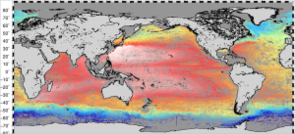The Synthetic Method
The synthetic method consists in removing for each observation of the total oceanic signal, the ocean variability measured by altimetry.
The temperature and salinity profiles are used to compute the synthetic heights. All temperature and salinity profiles from the CORA3.4 database covering the 1993-2012 period are taken into account.
Geostrophic velocities from drifting buoys (1993-2012) are extracted to compute the synthetic velocities.
Computation of the synthetic observations of heights
All the profiles are used to compute dynamic height hinsitu by integration of the temperature and salinity along the water column. Then a set of synthetic estimates of the mean dynamic topography is obtained according to the equation:
<h> = hinsitu - h'alti
However, by integrating the temperature and salinity measurements along the water column, the sea surface height obtained is representative of the steric content until the profile's depth. To return to a synthetic estimate of the ocean dynamic topography (barotropic and baroclinic components from the surface to the bottom), an estimate of the mean dynamic topography at the profile's depth needs to be added. This missing component is approximated by subtracting to a large-scale estimate of the mean dynamic topography (first guess), a large-scale estimate of the mean steric component referenced to the profile's depth.
By using the first guess in the computation of synthetic heights, the useful information that we will add to the first guess is the small scales (< 125 km) resolved by steric heights <h>.
Computation of the synthetic observations of velocities
In a similar way, geostrophic velocities extracted from surface drifter velocities can be used together with geostrophic velocitie anomalies computed from altimeter slopes. The synthetic observations of velocities are computed by subtracting, along the drifting buoys paths, the altimetric velocity anomaly to the geostrophic velocity extracted from the buoy velocity according to the equation:
| <U>= U insitu - U' alti and | <V>= V insitu - V'alti |
In addition to the geostrophic component, the velocity extracted from the drifting buoy path includes the tide currents, the Ekman currents, the inertial currents and others high-frequency ageostrophic currents. To extract the only geostrophic component from the drifting buoys velocities, each of these ageostrophic components should be modeled and subtracted from the buoy velocity.
The removal of tidal and high-frequency barotropic currents are, currently, not precise enough to correct the drifting buoys velocities. Only the component of the Ekman currents, computed along the path, is removed from the drifting buoys velocities. Note that drogued and undrogued buoys are processed in a different way. An Ekman model at 15m is subtracted from the drogued buoy velocities while undrogued buoy velocities are corrected from Ekman currents at 0m and also from wind slippage. Then a low pass filtering is applied to remove the signals with a period less than 3 days. Finally, the synthetic observations of mean geostrophic velocities are obtained after averaging in a grid box size of 0.25 ° by 0.25.
Those estimates of height and velocity are finally combined in a multivariate objective analysis in order to improve locally the first guess computed with the direct method.







